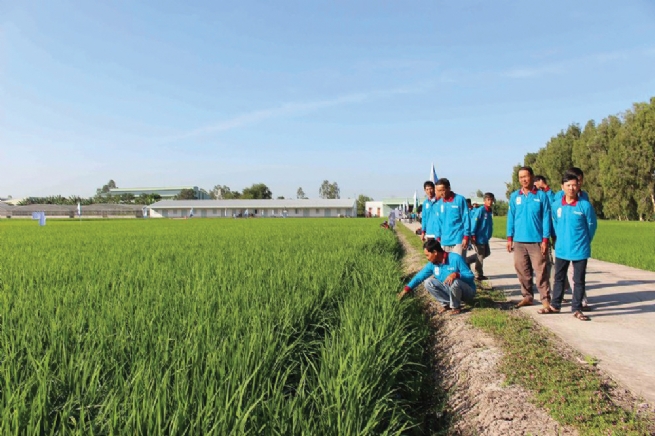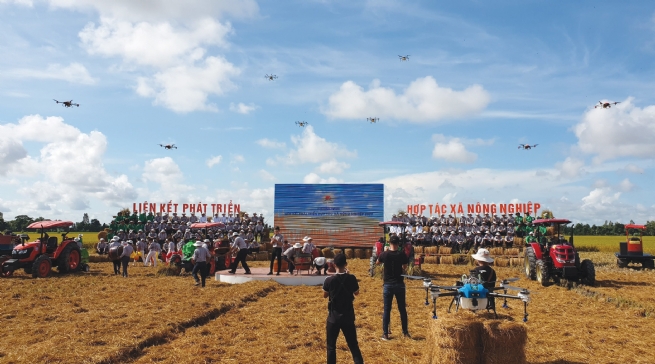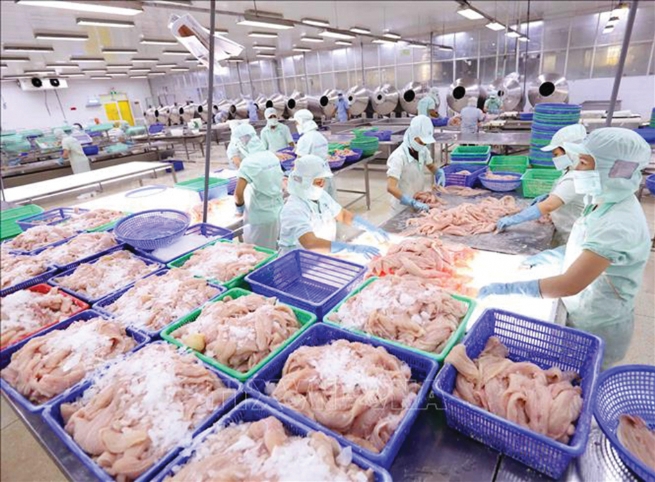Despite being negatively affected by global political turmoil and economic recession, unpredictable impacts of climate change, and risks of crop and livestock diseases, with its ongoing effort, the agricultural sector of An Giang province has still managed to grow and reaffirm its fundamental role in the economy. Vietnam Business Forum’s reporter has an exclusive interview with Mr. Nguyen Si Lam, Director of Department of An Giang Department of Agriculture and Rural Development.

An Giang is one of the key provinces in the Mekong Delta region that is renowned for its rice production and exportation
What do you think about the impacts of global political and economic situations on agricultural production in An Giang province?
The Russia-Ukraine conflict, global economic recession and recent unusual weather and epidemics have had a substantial impact on the agricultural sector of Vietnam, including An Giang province. This requires the whole sector to make every effort and focus all resources to effectively carry out its given tasks and targets. In the first six months of 2023, An Giang's agricultural and fishery sector grew by 3.29%, better than the performance a year earlier (growing 2.51%).
According to the An Giang Statistics Office, merchandise imports and exports grew both in volume and value the first six months of 2023.
The agriculture, forestry and fishery sector reaffirmed the underlying role of the economy, with two core products: Rice and pangasius, which boosted the export value to grow by 3.29% year on year in the first half of 2023 (2.51%). Agricultural, forest and aquatic production continued to be stable. Crop output and productivity increased slightly. Selling prices of most vegetables and fruits looked up, particularly green-skinned mango, Hoa Loc mango, jackfruit and cabbage cultivars.

An Giang is dedicated to developing a comprehensive value chain in the agricultural industry, from supply to production, processing, and export
Given current market difficulties and challenges, what solutions has the Department of Agriculture and Rural Development proposed?
First, the province continues to accelerate agricultural restructuring, shape the agricultural development strategy along the fishery - fruit - rice axis, and develop advantageous commodity sectors based on the following pillars: (1) Fostering innovations, creativity and sci-tech application to production to increase product quality and value; (2) Building trademarks and brands along with product traceability to meet domestic and export market standards; (3) Strongly developing agricultural investors, assigning enterprises as the locomotive to push the interconnectivity of production, processing and consumption of agricultural products; (4) Strongly developing the cooperative economy in a synchronous manner and in a multiple form: Developing a new value chain-based cooperative type linked with enterprises, developing multi-service cooperatives (manufacturing, linking input and output supply services for agricultural and aquatic products).
Second, further reforming and developing market demand-based production forms, with focus placed on developing agricultural enterprises and other forms of agricultural production and consumption cooperation based on value chains, connected with domestic and foreign distribution and consumption systems; further reforming and developing agricultural cooperatives, with attention paid to large-scale, high-quality commercial agricultural production associated with processing and consumption.
Third, strengthening research, transfer and application of science and technology, especially encouraging enterprises to participate in research and transfer of science and technology, applying high technology to create breakthroughs in productivity, crop and livestock quality, improving the sectoral competitiveness and efficiency, ensuring food safety and hygiene; further expanding the scale and improving the quality of farmer training, developing human resources to meet the sectoral industrialization and modernization requirements.
Fourth, improving market forecasting and promotion, searching for consumption markets, introducing and advertising products; attracting businesses, particularly big ones, to invest in agriculture and rural areas; mobilizing resources for synchronous agricultural and rural infrastructure development, and fostering the capacity for natural disaster prevention, mitigation and adaptation to climate change.
Fifth, raising the quality of agricultural human resources, training leading experts in each sector, field and value chain; giving priority to training managers for cooperative economic development; focusing on the work performance of the agricultural extension system, developing agriculturists, providing market information, and matching production with consumption.

Production activities at Cuu Long Fish Joint Stock Company are in full swing
The agricultural sector of An Giang province has made positive progress, integrated more deeply into the world market. Could you please tell us about the directions to be taken to boost those achievements?
In order to develop sustainable, modern, efficient, responsible and competitive agriculture and rural areas, the agricultural sector of An Giang province will plan to carry out the following contents in the coming time:
First, training and developing high-quality human resources, regarding this as a new growth engine and a key and important factor for sustainable agriculture development; changing thinking from simple agricultural production to agricultural economic thinking, boosting technological application to production to adapt to climate change and linking companies along value chains.
Second, reforming administrative procedures, supporting and removing difficulties and obstacles for businesses; further providing Level 3 and Level 4 public services concerning agriculture and rural development online; improving the investment environment; enhancing the publicity and transparency of procedural settlement to build the trust of investors and businesses to attract industry-leading investors and corporations to An Giang province.
Third, investing in upgrading transport, agricultural and rural infrastructure to better serve agricultural production, transportation and consumption needs in the province.
Fourth, restructuring agriculture based on local advantages, effectively using resources and aligning production with market demand.
Fifth, building concentrated material areas with geographical indications and traceability to meet international quality standards.
Sixth, strongly applying scientific and technological achievements and mechanization to agricultural production; adopting smart, high-tech agricultural models powered by IoT technology, circular agriculture and organic agriculture.
In recent years, An Giang province has been very resolute to carry out administrative reform and improve the business investment environment and achieved many positive results. So, how has administrative reform in the agricultural sector been focused?
The Department of Agriculture and Rural Development has reformed administrative procedures in a drastic, substantive and effective manner; and stepped up publicity and transparency of procedural settlement, thus helping build the confidence of investors and businesses in agriculture-related administrative procedures.
The department has provided 90 out of 95 administrative procedures online: Partial online for 47 administrative procedures (Level 3), full online for 43 administrative procedures (Level 4), and ongoing reviews of procedure levels for five administrative procedures. The department has reviewed public services qualified for Level 4.
The department established a business and PAR support board, attracted investment funds for agriculture and rural areas, supported and accompanied companies to deal with their difficulties and obstacles, and researched and proposed solutions to speed up public administration reform and woo more companies to invest in agriculture in the province.
Thank you very much!
By Quoc Hung, Vietnam Business Forum